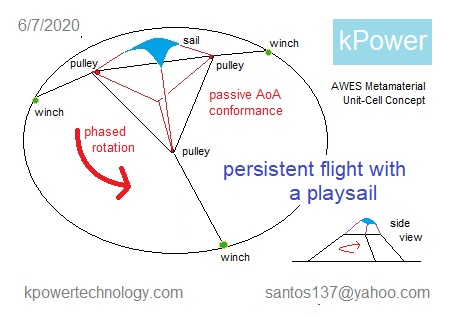Developing
Cascaded and Hot-Swapped
AWES Tri-Tethers
Cascaded and Hot-Swapped
AWES Tri-Tethers
Developing Cascaded and Hot-Swapped AWES Tri-Tethers
Motivation:
Tri-tether AWES are shown capable of generating crosswind power from any wind direction, as well as persistent kite flight by reverse-pumping. Much basic R&D remains to fully exploit and scale-up tri-tether art, eventually in GW-rated metamaterial lattices in persistent flight.
Specific Design Challenges:
- Phased circle-tow of a small tri-tether pilot-kite/glider to usable wind altitude. Use to assist cascade-launch of larger tri-tether rigs in successive stages.
- Hot-swap in flight any subset of tri-tether components to match wind and load conditions, or upgrade components, or repair damage.
- Create a vertical tower of kites by superposed tri-tether stages.
-------------
kPower has been doing successful empirical design/build/test of tri-tether concepts since 2008.
The top tri-tether academic reference is:
Assessment of an Alternative Concept for a High-Altitude Wind-Power Generator
Journal of Physics Conference Series 1037(4):042023 June 2018
Max Langbein, Maja Ruby, Nicolas Gauger
Technische Universitšt Kaiserslautern
DOI: 10.1088/1742-6596/1037/4/042023

Soft-Kite Tri-Tether MetaMaterial Cell
AirborneWindEnergy/PersistentFlightWithPlaySail.html
More notes ...
More notes, touching on points raised by your inspiring paper, summarizing related art and opinion-
- Two partial prior art tri-tether cases- vintage Zeppelin 3r anchoring patent and Tigner's AWE patent.
- Higher load velocity as key advantage of crosswind load trajectories like 3r, over 1r downwind reeling. Less transmission machinery is needed to gain high angular shaft velocity.
- Tether drag almost negligible with large slow power kites, after all 4 lines is the kitesport and PG standard. High L/D wings are far more tether-drag limited. 3r multi-lines can be thinner than 1r and still more resistant to runaway.
- Optimal to maintain max working load of kite (~2x safety factor), not, eg., rated human load (~8x safety factor). Elastic aft bridling dumps excess load like a shock absorber.
- UHMWPE and Nylon return most of their elastic energy when tensioned-untensioned. Elasticity is more of a dynamics issue than a source of loss, in normally proportioned rigs.
- No hills or towers really needed; turf-grass/hay is a fine surface that does not degrade kites, and the hay is an extra carbon-crop. A large dragged kite actually floats over grass, as a fluidized bed. An elevated 3r bridlepoint invites a looping foul of the kite around the downwind leg. The kite can be moved about and launched from a wheeled trolley. Good passive-control kites want to fly, and take off readily. "Kitekillers" are a means to avoid landing uncertainties.
- AWE is "sailing in the sky", still requiring skilled human labor to be productive. Full automation of large AWES is a distant hope, but a kPower looping foil under a pilot kite kite has run all-modes for two weeks, since the sled pilot kite always self relaunched after lulls. The outdoors is simply too dynamic and not structured enough for industrial automation. FAA requires Pilot-In-Command and Visual-Observer. Supervisory automation is the sweet-spot.
- Three lines form a rigger's triangle, a mechanical advantage transmission. A bowstring and arrow act similarly to what a tri-tether can do.
- Macroscopic application of QM methods is called "analog QM", to distinguish from microscopic QM. As such, there are fine similarity cases, like Yves Crouder et al, with walking-drop experimental model. De Broglie-Bohm Mechanics is now applied in economics, sociology, and other fields.
- Single-skin kites may ultimately dominate by both cost and power-to-mass, at slightly lower L/D. SS progress is revolutionary in PGs and power kites. The NASA Power Wing remains a potent wing, popular with DE kite-skateboarders. These kites must stay on a trajectory surface, since they do not glide back fast like a hot kiteplane.
- Control Theory is another useful analytical lens. Conventional AWE control theory presumes algorythmic digital control with sensing and actualtion. Classic kite passive dynamic stability of equivalent functionality is far more elegant classical cybernetics (Gauss saw toys as profound mathematical objects). Active digital control can be dedicated to supervisory override, exception-handling, mode transitions, active tuning, etc. Passive control is an embodied-logic analog computing case, even a quantum computing analog where DOF states embody qubits.
- Standing Lattice waves are Faraday Waves. Acoustics, heat, and mechanical action are all phonon waves under scale invariance. Lots of applicable wave science in in disciplinary silos. Classical harmonic analysis and resonance are key kite attributes. Synchrony emerges naturally from periodic order of spring-mass units.
- A cool AWE scicomp project would be a dynamic simulation environment hosting endless promising combinations of kite/tether/wind/load, assessed in real time. An ultimate AWE scicomp concept could consist of public global wind geodata overlaid with load demand-interface geodata, supporting global AWES infrastructure simulation, an engineering basis for solving the global clean energy gap with kites.
- KiteLab 3r demos played out the pulleys from the anchor points to match wind direction and kite angle to fixed center generator. Lowest part count and simplest cheapest parts drove transmission design.
Hope something here helps,
dave